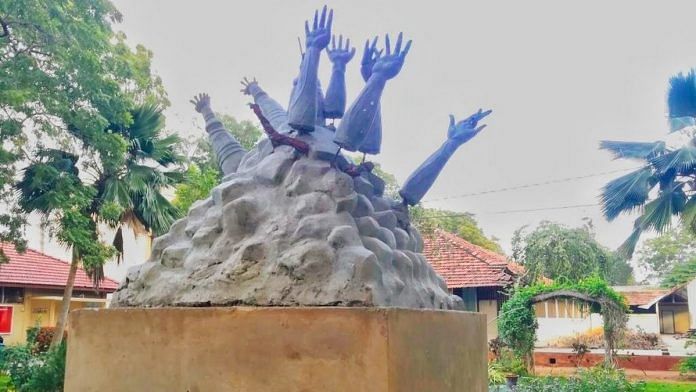New Delhi: On the night of 9 January, many students, including the mayor of Jaffna, Vishwalingam Maniwannan, protested outside the gates of the University of Jaffna in Sri Lanka, around 260 kilometers from Colombo.
The students were protesting the university’s decision to raze a war memorial commemorating massacres that took place during the last leg of the three-decade-long civil war that ended in 2009 at Mullivaikkal, a small village in the northeast coast of Sri Lanka.
On Saturday, Jaffna University issued a warning to protesting students. Vice Chancellor of Jaffna University, S. Srisatkunarajah, released a statement saying, “If they do not go by themselves we will deal with them.”
The memorial was erected by university students in 2019. It was reportedly sculpted by a student who lost his father when his family was trying to flee the conflict zone.
According to a report by the United Nations, over 40,000 Tamilians lost their lives in the final months of the civil war. Sri Lankan government pegged this figure at 9,000 civilians. A large number of these casualties were reported from Mullaitivu district, where Mullivaikkal is situated.
ThePrint explains the history behind the Mullivaikkal massacre.
The Sri Lankan civil war
The Sri Lankan civil war, which started in 1983, was a result of the historic animosity between the majority Sinhalese, who follow Buddhism and minority Tamils, who largely follow Hinduism.
After attaining independence in 1948, the Sinhalese overwhelmingly occupied government ranks and introduced policies for the Sinhalese and marginalised Tamils. The government believed this was a way to redress the disadvantages faced by Sinhalese under colonial rule. Reports of communal violence started pouring in from 1956 and radicalisation of the Tamilian community had begun. By mid-70s, though some Tamilian parties participated in the democratic discourse, some groups started calling for a separate nation state, ‘Tamil Eelam’ in the north-eastern areas of the country.
The Tamil New Tigers, which was formed in 1972 and became the Liberation Tigers of Tamil Eelam (LTTE) in 1976, was the main group that was fighting for Tamil rights. It had been declared a terrorist outfit by the Sri Lankan government. This group was also responsible for the assassination of Rajiv Gandhi.
The bloody events of Mullivaikkal was the last leg before the war ended in 2009.
Also read: 28 years after Rajiv Gandhi’s death, a look back at the LTTE-Lanka nexus that killed him
Mullivaikkal massacres
Between January and May 2009, the Sri Lankan Government unilaterally announced the successive establishment of three No Fire Zones (NFZs) inside LTTE areas, without agreement with the LTTE. These zones were established in LTTE-captured areas where civilians could seek shelter from the armed conflict.
Each successive one was smaller than the previous, and further east towards the coast as the LTTE retreated further and further back.
Even though the Sri Lankan government had assured it will not fire in government-declared NFZs, there was repeated shelling of these areas, and civilian hospitals and homes were also targeted.
As military captured LTTE-controlled areas, Tamilians fled to the last remaining bastion, Mullivaikkal — which had been declared a no-fire zone — to seek shelter. The government of Sri Lanka, meanwhile, repeatedly denied firing in safety zones or targeting hospitals.
On 2 May 2009, the Sri Lankan military reportedly attacked the last hospital in the region killing 64 and injuring as many as 87 people.
According to some reports, as many as 40 shells were dropped on civilian areas. In the repeated attacks as many as 100 people died every day.
On 9-10 May 2009, there was heavy shelling in congested areas of the no-firing zone. Many families were killed in the attack, with several reportedly dead in their bunkers.
Dr V. Shanmugarajah, a doctor in the conflict zone, had told The Guardian that up to 1,400 people had died within two days due to heavy air and artillery attacks.
The Sri Lankan military has been accused of gross human rights violations, especially in the final stages of war in 2009.
Rajapaksas in power
In a tweet on 8 January, Jaffna University’s former head of the Law Department, K. Gurupuran alleged that the University’s previous Vice-Chancellor was sacked because he refused to demolish this monument and he believes “that one of the pre-conditions for appointment of the new VC by the incumbent President was demolition of this monument.”
The 2009 offensive against the LTTE, which finally concluded the decades-long civil war between the majority Sinhalese and minority Tamilians, was led by the current Sri Lankan Prime Minister Mahinda Rajapaksa and current President Gotbaya Rajapaksa.
Shortly after Rajapaksa brothers were voted to power in November 2019, Mahinda Rajapaksa announced the government’s decision to withdraw from co-sponsoring a UN Human Rights Council resolution on accountability for war crimes.
The Prime Minister had given the statement shortly after US imposed travel restrictions on Lt. Gen. Shavendra Silva and his immediate family members over alleged violations of human rights during the final phase of the civil war.
The UN resolution was signed in 2015 by the Sri Lankan govt led by then president Maithripala Sirisena. It called for an independent investigation into the human rights violations in the Sri Lankan civil war.
The Human Rights Watch also reported that Sri Lankan security forces and intelligence agencies have increased surveillance on families of those who disappeared between 2005-15 after Rajapaksa became president in November 2019.
Rajapaksa also halted legal proceedings against Navy officers accused of enforced disappearances and alleged killings of 11 young men in Colombo and its suburbs between 2008 and 2009.
Also read: With strong Rajapaksa govt in Sri Lanka, India to push big list of projects to boost ties




It wasn’t the university’s decision!!
It was the Sri Lankan government, who decided they were going to demolish the monument. Stop reporting false information. Actually do your research!!!!
LTTE not llte.